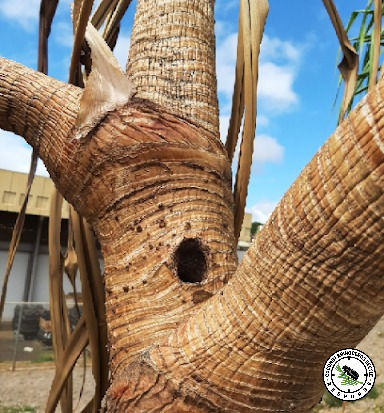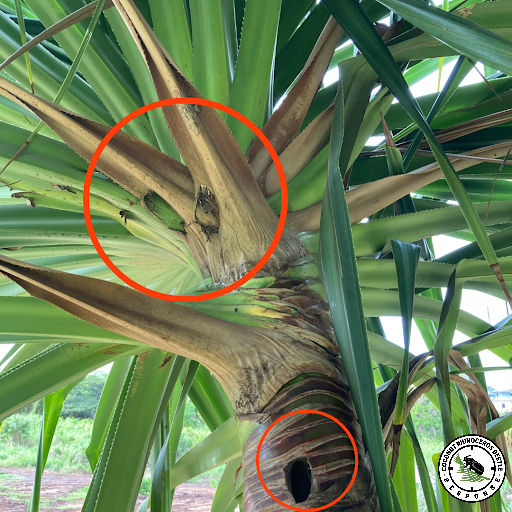How to identify coconut rhinoceros beetle feeding damage
- Coconut Rhinoceros Beetle Response
- Jun 7, 2022
- 2 min read
Updated: Jul 1, 2025
Coconut rhinoceros beetles (CRB) are a major pest of coconut trees and fan palms, but they can feed on other palms (including royal, date, and foxtail palms) and even plants like hala, kalo, sugarcane, and pineapple. Even if you are familiar with CRB damage to coconut trees, damage looks different on other palms and host plants.
Adult CRB bore into the crowns of trees, leaving behind 1.5 - 2” boreholes. This exposes the plant to secondary pests and diseases, decreases growth and production, and significant CRB feeding damage can kill the plant. Palm fronds will show damage after the feeding event occurs, but the exact damage pattern and time it takes to emerge will vary depending on the type of palm. Damage to palms is an alert to possible CRB infestation and breeding activity nearby. This guide covers which plants to inspect for signs of CRB and other factors that can cause similar symptoms.
CRB damage to coconut trees first appears as 2” boreholes at the crown of the tree. Weeks or months later, after the immature frond unfurls, the tree will show evidence of CRB feeding with v-shaped cuts. Damage to inner fronds indicates more recent feeding, and damage to outer fronds indicates feeding from several months prior.


CRB damage to fan palms: Pritchardia and other fan palms are susceptible to CRB damage. However, palmate leaves demonstrate CRB damage with scalloped edges and cuts that look straight depending on your viewing angle.


Damage to other palms: The CRB Response has documented fewer examples of CRB damage to date and royal palms, but in high catch areas CRB are known to feed on these species.

CRB damage to date palms. Look for boreholes and angled cuts.

CRB damage to other palms, especially those with “bushy” fronds, can be more challenging to identify. Look for scalloped edges on leaflets and conical cuts to the fronds.

Look for angled, conical cuts on palms with leaflets on multiple planes.
CRB damage to hala:
Five examples of CRB damage to hala have been documented in Pearl City Peninsula, a sustained high-catch area for CRB. At least two of these trees have not survived after significant damage. Boreholes look similar on hala, but instead of v-cuts, look for repeated holes on leaves.


Other causes of tree damage:

Tree trimming can cause damage that looks similar to CRB feeding damage, especially if the spear is cut. Look for straight cuts without scalloped edges on coconut trees and nearby power lines.

Rats can cause damage to CRB host trees as well, which displays as uneven leaflet damage near midrib.
On Oʻahu, the CRB Response has not yet documented CRB damage on sugarcane, kalo, pineapple, papaya, or many other less common CRB food sources. If you see suspect CRB damage on any CRB host plant, please note your location and send us a photo.







Run 3 offers no forgiveness for careless moments. Platforms vanish fast, and tight turns leave no room for error. Staying alert keeps you alive.
What makes Snow Rider 3D so irresistible is its blend of simple controls, smooth physics, and visually stunning 3D environments.